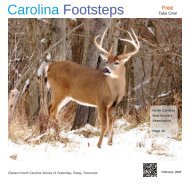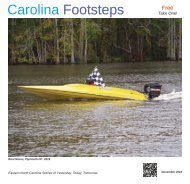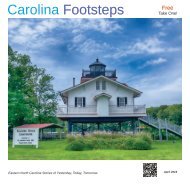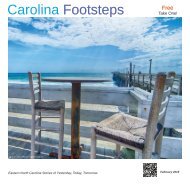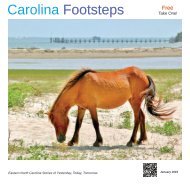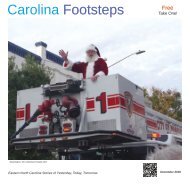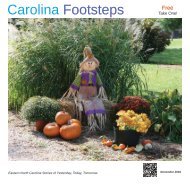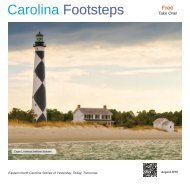Footsteps October 2019
October edition of the Carolina Footsteps now online.
October edition of the Carolina Footsteps now online.
- No tags were found...
You also want an ePaper? Increase the reach of your titles
YUMPU automatically turns print PDFs into web optimized ePapers that Google loves.
Three Surprising Ways to Save<br />
Money on Pet Care<br />
(NewsUSA) - Owning a pet comes with a lot of benefits -- but<br />
caring for a pet can also have an unwelcome impact on your<br />
budget. According to the ASPCA, owning a dog or cat can<br />
cost up to $1,000 in the first year, and many people end up<br />
spending much more. The good news is, you can cut your<br />
pet care expenses without compromising your pet’s health<br />
and<br />
wellbeing. Here are a few tips to save money on pet care:<br />
1. Don’t skip the vet.<br />
If you’re trying to save money, it can be tempting to cut back<br />
on veterinary visits. But, according to Julie Ciarmella of the<br />
American Veterinary Medicine Association, “an investment in<br />
preventive healthcare can reduce your long-term pet healthcare<br />
costs.” Why? Because regular check-ups can prevent<br />
expensive complications down the road.<br />
2. Get by with a little help from your friends.<br />
Dog-walking, pet-sitting and kennel services can be one of<br />
the most expensive aspects of owning a pet. You can save<br />
money by taking the “you scratch my dog’s back, I’ll scratch<br />
your cat’s chin” approach and tapping into a network of other<br />
pet owners in your area. Neighborhood dog parks are great<br />
places to meet like-minded pet lovers; or you could try good<br />
old fashioned advertising.<br />
3. Choose high-quality pet products that give you more value<br />
for your money.<br />
Reaching for the cheapest product can feel like a thrifty<br />
move, but you may be surprised by the impact “cheap” products<br />
can have on your budget. For example, cheaper clay cat<br />
litter needs to be changed more often -- so cat owners go<br />
through bag after bag. World’s Best Cat Litter is an alternative<br />
that harnesses the concentrated power of corn for<br />
long-lasting performance. You’ll use less litter, replace it less<br />
often, and save money in the long run.<br />
In the end, remember that what your pet needs most is love.<br />
Keep things simple and invest in high-value products where<br />
it matters, and you’ll be on your way to a pet-care budget<br />
that works for you.<br />
Adam’s Needle<br />
By: Coy Domecq<br />
I<br />
t never ceases to amaze me at the beneficial uses of plants<br />
that we walk by every day without ever realizing their attributes.<br />
For me Adam’s Needle, Yucca filamentosa in the agave<br />
family, is but one of these plants. This plant is a rosette of<br />
sword-shaped spiny-tipped leaves and spikes of creamy white<br />
flowers when in bloom. Adam’s Needle is native to the southeast<br />
US and can be found especially among coastal plain locales<br />
but does well in just about any place with well-drained soil and<br />
exposure to full sun. This plant was and continues to be used<br />
by Native Americans for a host of applications, from food source<br />
to medicinal remedy. Before we proceed, the standard caution<br />
applies that one should never consume any plant without positive<br />
identification and knowledge of proper preparation. Like all yuccas<br />
and other similar plants, Adam’s Needle especially the root<br />
contains saponins, soap-like chemicals that, unless leached by<br />
repeated washings might cause stomach distress. These are not<br />
medical recommendations but rather a recount of historical and<br />
contemporary use to treat ailments. All parts of the plant can be<br />
consumed; the flowers, immature fruits, stalk, root, and seeds are<br />
typically boiled or roasted. Medical uses include a dermatological<br />
wash, ointment or salve for rashes and skin diseases, a treatment<br />
for strains and sprains and even as decoction for the treatment<br />
of diabetes. Other practical uses of the plant are for use as a detergent,<br />
fire starter made from dried fibers, cordage from twisting<br />
individual fibers, and handily enough a needle with the filamentous<br />
thread already attached.<br />
This could be your Ad!<br />
Advertising with Carolina <strong>Footsteps</strong><br />
Magazine is Local, Targets an<br />
audience and is Frequent.<br />
Call us at (252) 377-5296<br />
We display your business<br />
to different demographics,<br />
in Print, Internet, and Social<br />
Media. All at a cost that<br />
is less than regular print ads.<br />
Oct. <strong>2019</strong><br />
For more Dr. Dave recipes, a book is<br />
available by contacting Dr Dave at<br />
252-312-0295<br />
All proceeds go to the Oak Grove<br />
United Methodist Church<br />
Spoon Rolls<br />
NATURE 11<br />
1 package of dry yeast<br />
2 cups of warm water<br />
1/4 cup of sugar<br />
3/4 cup of vegetable oil<br />
1 egg<br />
4 cups of self rising four<br />
1/4 cup of self rising corn meal<br />
Dissolve package of yeast in warm<br />
water in a bowl<br />
Add remaining ingredients, mix well<br />
and store in fridge until ready to bake<br />
spoon batter into greased muffin tins<br />
bake at 425 degrees for 20 minutes.<br />
Dr. Dave is an Ivy League<br />
Trained Executive Chef and Early<br />
American Historian




